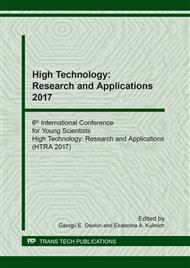[1]
M. Epple, Biomaterials and biomineralization, Veter, Tomsk, (2007).
Google Scholar
[2]
B. Yang et al, Preparation of bioactive titanium metal via anodic oxidation treatment, Biomaterials 25 (2004) 1003–1010.
DOI: 10.1016/s0142-9612(03)00626-4
Google Scholar
[3]
P. Stenlund et al, Bone Response to a Novel Ti-Ta-Nb-Zr Alloy, Acta Biomaterialia (2015) 1-36.
DOI: 10.1016/j.actbio.2015.03.038
Google Scholar
[4]
S. G. Schneider et al, Mechanical properties and cytotoxic evaluation of the Ti-3Nb-13Zr alloy, Biomecánica 8 (2000) 84-87.
DOI: 10.5821/sibb.v8i1.1653
Google Scholar
[5]
M. Niinomi, Recent metallic materials for biomedical applications, Metallurgical and materials transactions A., 33 (2002) 477-486.
DOI: 10.1007/s11661-002-0109-2
Google Scholar
[6]
M. I. Z. Ridzwan, S. Shuib, A. Y. Hassan, A. A. Shokri, , M. M. Ibrahim, Problem of stress shielding and improvement to the hip implant designs: a review, J. Med. Sci. 7, (2007), 460-467.
DOI: 10.3923/jms.2007.460.467
Google Scholar
[7]
S. Bahl, S. Suwas, K. Chatterjee, The importance of crystallographic texture in the use of titanium as an orthopedic biomaterial, RSC Advances. 4 (2014) 38078-38087.
DOI: 10.1039/c4ra05440g
Google Scholar
[8]
V.V. Samoylenko et al, Influence of rolling and heat treatment on the structure and properties of the coatings fabricated on the titanium substrates by electron beam cladding, Obrabotka metallov: tekhnologiya, oborudovaniye, instrumenty. 2 (2015).
Google Scholar
[9]
A. Rozenfeld, Uskorennyye metody korrozionnykh ispytaniy metallov, Mettalurgia, Moscow, (1966).
Google Scholar
[10]
H.P. Lee, C. Esling, H.J. Bunge, Development of the rolling texture in titanium, Texture, Stress, and Microstructure. 7 (1988) 317-337.
DOI: 10.1155/tsm.7.317
Google Scholar
[11]
S. Bahl, S. Suwas, K. Chatterjee, The control of crystallographic texture in the use of magnesium as a resorbable biomaterial, RSC Advances. 4 (2014) 55677-55684.
DOI: 10.1039/c4ra08484e
Google Scholar
[12]
U.D. Veryatyn, V.P. Mashiraev, N.G. Ryabcev, Termodinamicheskiye svoystva neorganicheskikh soyedineniy. Spravochnik, Atomizdat, Moscow, (1965).
Google Scholar


